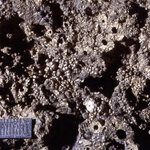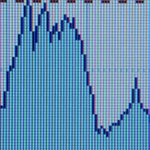Chemistry

The Primordial Soup theory of the origins of life on earth has been cooling for years. Probably, by now, it's too cold to reheat.
Abiogenesis, or the study of how life originated from Earth (and Universe) stuff, connects the Earth and Life sciences, for me.
A research team from the University College, London focused their new research into the origins of Earth life on deep sea vents, where geochemical gradients across microscopic caverns could have acted as catalytic cells, generating precursors of the carbon and energy metabolism found in all organisms, which the first true, free-floating…

Scheikunde
is Dutch for Chemistry, and literally means "Separation Science". Now, if one has a carpet made of 85% polypropylene and 15% wool, how does one go about separating them?
Have no fear! Nature already has a solution. I found these cocoons (about half a centimetre long) on the surface of said carpet, and decided to look at them under a video microscope. This is what we saw:
VIDEO
As you can see, these caterpillars emerged from the cocoons and resumed their analysis, selectively removing the wool fibres from the polypropylene matrix.
(Note: to pronounce…

Northwestern University researchers have developed a new material that could help with the remediation of nuclear waste that behaves much like a Venus Flytrap, permanently trapping only its desired 'prey,' the radioactive ion cesium. The results were published online this week in Nature Chemistry.
The synthetic material, made from layers of a gallium, sulfur and antimony compound, is very selective. The researchers found it to be extremely successful in removing cesium -- found in nuclear waste but very difficult to clean up -- from a sodium-heavy solution. (The solution had concentrations…

Wine. You can earn a degree for studying it (enology), earn a living being an expert at it (Sommelier) or fake wine know-how to get through a dinner party. Wine lovers (oenophiles),
In the beginning, like attracts like to make a dimer. Nobel Prizes are a rich source of dimers. I counted twenty-three Nobel Lectures with dimers. The wealth in dimers can compound a case not only in biochemistry but also in organic chemistry. A new certainty sparkles here with a metal form, the beryllium dimer.
Beryllium is a fascinating metal of sweetness. Would you remember Be and its compounds are too toxic for a taste? Nevertheless, early experimenters were led to lick to…

A new study conducted by scientists in France concludes that the alluring eye makeup worn by ancient Egyptians also may have been used to help prevent or treat eye disease by doubling as an infection-fighter. The study appears in the January 15 issue of Analytical Chemistry.
The researchers note that thousands of years ago the ancient Egyptians used lead-based substances as cosmetics, including an ingredient in black eye makeup. Some Egyptians believed that this makeup also had a "magical" role in which the ancient gods Horus and Ra would protect wearers against several illnesses. Until now…

Separation science has seen glamour and growth with ever-increasing demand for analysis ranging from environmental, toxicological to forensics. The list is endless and the genre is getting narrower for the graduates. Considering these points, eminent professors and research scientists have rolled out a wonderful interface for evolving pedagogy. separationsNOW marks and celebrates chromatography education through webinar series, " Year of Education in Separation Science." It is fascinating and interesting interface to ask generic to advanced questions. I was…
That's right, my love for the periodic table can now be extended to my phone! My sweet Palm Pre features the periodic table in its app catalog, with such data as:
Oxidation Status
Boiling Point
Melting Point
Electron Configuration
Electron Negativity
Atomic Radius
Atomic Volume
Specific Heat Capacity
Ionization Potential
Atomic Number
Symbol
Name
Weight
Link to Wikipedia article
Man, I thought we were cutting edge when we were able to spell 35006 on our calculators in math class.1 The link to the Wikipedia article is a nice touch, I thought. BHE (Best Husband Ever) paid for the app so I…

When Dmitri Mendeleev first published his table of elements in 1869 (picture), only 60 of these were known. One group in particular was absent, namely the inert gases. Now you may have heard this song:
"All these gases are inert Helium, neon, argon.I’ll sing this song until it hurts Krypton, xenon, radon." **
Helium, though, had only been suggested in 1868 when two astronomers (Janssen and Lockyer) had separately observed its spectral lines during a total solar eclipse. It was only in the 1890s that Sir William Ramsay discovered first argon, then krypton, neon, and…
Who does not like a mystery? The universe is mysteriously rich in hydrogen. Three-quarters of its mass is hydrogen. On the other hand, our planet is mysteriously xenon-poor compared to other rocky planets such as Mars, Venus, and Mercury. In 1997, Wendel Caldwell et al. published in Science on the missing Xe. Their research combined laser-heated diamond anvil cell experiments with quantum mechanical calculations to uncover whether noble xenon is alloyed with iron in the Earth's core. No tendency was found on the part of xenon to form a metal alloy with…